A well-groomed fat bike trail makes a huge difference for all levels of riders. When the conditions are less than ideal, riding on a non-groomed trail can end in a severe injury.
Fortunately, there is more knowledge than ever out there relating to grooming fat bike trails. Not only do people understand the importance, but more importantly, they know the science behind it. Snowy trails need the right treatment at the correct times to make riders feel safe.
We take a look at everything from grooming a fat bike trail to proper etiquette on the trails. If everyone knows a bit more about the grooming process, it makes fat bike riding all that more enjoyable.
Why Are Fat Bike Trails Groomed?
Isn’t the point of riding a fatbike all about tackling any situation without fear? To a certain degree, yes, but a fat bike trail can make a ride enjoyable, while also keeping everything challenging.
Grooming fat bike trails mostly happens when snowfall is a bit too high and/or fresh. While it might be possible for some riders to make their way around a typical trail still, it is too challenging to deal with the hassle.
Riders love this so much that people are beginning to think that the future will consist of a lot more groomed tracks.
Right now, most courses are multi-use. Fat bike riders share the trail with other forms of transportation. Singletracks are becoming popular, allowing for the same type of ride as what someone gets in the summer on dirt or sand.
Finding Groomed Fat Bike Trails
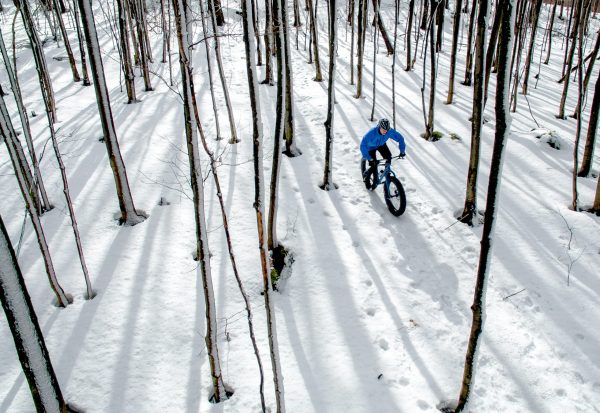
The easiest way to groom a fat bike trail is not to be responsible for doing it. There are a growing number of options out there that are very organized for fat bike riders.
There are also more local types of fat bike trails that are groomed by people who do it for the love of the sport.
Search around locally to see what options might be out there for groomed fat bike trails. There might just be more than people think, especially in fat bike hotbeds. Some locations charge a fee, but even the fanciest places are not that much.
Talk to enough people who ride fat bikes, and the recommendations will start coming out. Like most things in the fat bike niche, many are eager to share location tips, hidden spots, and more. They see it as growing the sport they love and enjoy.
A big part of the fat bike riding experience is also passing on any information to others in the future. Letting people know about where the best-groomed trails are will help out. If they are well taken care of, it won’t matter that the trails are a little busier. If anything, it will continue to grow the sport in that area, and make more of these groomed trails pop up.
How To Groom a Fat Bike Trail the Right Way

Some people have the luxury of using a fat bike trail that is groomed by another person or an organization to help out all the other riders. It is the easiest method to enjoy riding a fat bike, but some people have to do it themselves to make the most of a ride.
Having a groomer is the most important thing, as no one can groom a bike trail of any kind without it or something like it IF the snow is too deep to make a path simply using your fatbike tires. There are ways to purchase it already, or to make a homemade groomer.
Grooming almost always occurs with some sort of motorized vehicle like a snowmobile. This is because going over that snow for the first time is too challenging for fat bike riders. After the initial grooming, touchups are possible with fat bike riders dragging a groomer.
There are some things to keep in mind when grooming a fat bike trail. It’s not always the same as other types of trails, so having fat bikes in mind will make it better for everyone.
Homemade Fat Bike Trail Groomer
There are many ways to groom a fatbike trail that does not involve buying a professionally built trail groomer. There are a few ways to do it the DIY way!
One way you can groom a trail is by dragging a couple of tires behind your snowmobile. Dragging the tires will help smooth out the tracks left by the snowmobile but make sure you still have the rims on the tire to give it that extra weight because otherwise, the tire would just float over the tracks and not do much in terms of grooming.
I would personally recommend dragging at least two tires if not three. This way each tire is smoothing out the trail left by the tire in front of it and so on.
I find tires work a lot better in mountain bike trails in the forest because a heavy duty groomer might be a bit too wide to pass through the narrow MTB trails especially if you have to groom over rocks and roots when there are just a few inches of snow on the ground.
A Wider Width is Usually Preferred
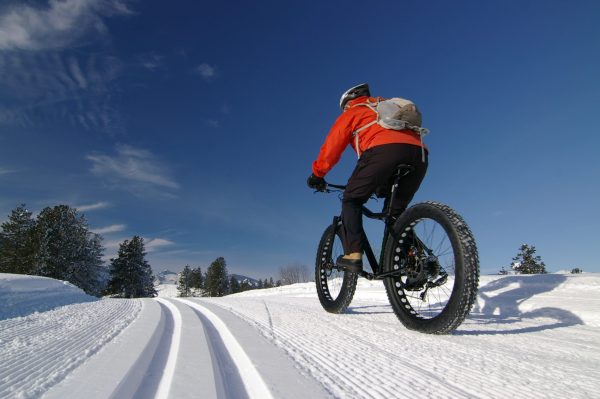
It is a huge challenge to go with a very narrow strip for a trail. Some riders prefer it, even if they are in the minority. Not only does it make the ride challenging, but it is usually easier for someone to groom a trail themselves without any fancy set up.
However, the vast majority of people prefer trails that are somewhere between 1.5’ up to 4’. This gives a rider plenty of room to move around, and it also allows for multiple riders to make a trip in a pack without feeling too bunched up.
Of course, getting the width perfect across the entire trail is pretty much impossible. With so many obstacles in the way, such as trees and huge rocks, it might have to be narrow during certain parts.
Another thing to consider is that the groomer’s width is not going to be the same as the width of the trail once finished. A trail usually only ends up being used for 2/3 of the width of the groomer. That means a 36” groom is only going to make a trail that will be usable for about 24”.
A common suggestion is to go as large as possible for a groomer and adjust from there. Even if the trail ends up being a bit too wide, it is better than going to narrow.
Nailing The Firmness
The key to a successful groom of a fat bike trail is the firmness. A firm trail is going to be very fast and fun. It also tends to be safe overall for all types of riders. The problem is, it takes a lot of effort (and riders) to get the right type of firmness. Some people don’t have the patience for it, and it leads to subpar conditions.
Perhaps the trickiest part is making sure that the snow holds together well enough for excellent traction overall. Fresh snow is hard to get to act correctly because the crystals are larger and sharper than usual.
This snow does not compact well since there is a limited-contact area. A good groomer will have the ability to break apart the snow crystals so that they are smaller, allowing for easier bonding to make a firm trail.
Another key to firmness with new snow is to mix in old snow with it. This mixture helps to knock some of the unneeded air out of the snow. Fresh snow can look very beautiful from a distance, but it doesn’t do much good for an actual trail. A good tilling machine will work the snow around so that there is a mixture that makes a firm trail overall.
One of the keys for any person who is in charge of grooming a trail is that they need to make sure that they are willing to adapt based on conditions. Not every grooming task is going to be the same.
Once a person gets more familiar with the groomer and the fat bike trails itself, they know what methods to use for certain situations. Firmness is the hardest to get down correctly, but it pays off hugely down the road.
Think of firmness for a trail as creating snowballs. Fresh snow usually doesn’t do particularly well, because it doesn’t bond together and make a particularly great ball to throw. Combining fresh snow with some older wet snow makes snowballs so much better.
Adding Texture and Fixing Issues On the Trail
The initial preparation for a fat bike trail is very important, but the finishing touches can make a huge difference. That means making the trail as smooth as possible right before people ride on it, and fixing the trail when needed.
A trail can seem pretty smooth at first, but if it goes through a thawing and refreezing cycle, the trail can quickly become pretty bumpy. It might be a pain, but it’s essential to continually maintain and fix the trail to keep it running smoothly. That means fixing bumps, divets and other issues that pop up.
How are these all fixed? It’s related in a lot of ways to the initial preparation of a fat bike trail. Taking care of the top layer and breaking up any icy parts will help out quite a bit. If it is possibly snowing throughout the day, it probably needs at least a few grooming treatments to keep up with how everything is changing.
No one will ever mistake grooming a well-used fat bike trail as easier. In fact, even if it is not used much, grooming and making fixes is always needed based on the weather conditions. Be prepared to make fixes at any time.
Other Common Trail Grooming Questions
From time to time, other grooming-related questions will come up. Since a lot of grooming involves trial-and-error based on specific locations, the learning process is never-ending.
How Important is Trail Grooming in Non-Snowy Conditions?
For the most part, fat bike trails don’t need a ton of grooming in non-snowy conditions. A fat bike build handles a lot of what it encounters, so people like having a challenge in trickier areas.
The biggest difference-maker is any type of precipitation. If there is a lot of mud on the trail, to the point that tires get stuck, that is problematic. Most people will decide just to wait it out rather than try to groom it. Others just buckle up and enjoy the challenge.
What is the Best Part of the Trails to Ride On?
It always makes the most sense to ride the firmest part of the track possible. As long as there are no ruts that are in the way, this will provide the most efficient type of riding.
One thing for sure, however, the more fat tire traffic a trail gets the better the trail will end up being. Sometimes traffic is all a trail needs to become firm and fast!
What is the Proper Way to Treat Trail Groomers?
Since fat bike riding is such a small community in many locations, it is important to treat everyone with as much respect as possible. The trail groomers should be taken care of and helped out by so many other riders out there.
Perhaps the best way to help out is to donate money and time when possible to trail groomers. They are making everyone’s life that much easier and more enjoyable.
One thing most of them love is craft beer. It would certainly be greatly appreciated to bring them some fresh beer from a local brewery for their efforts in making the trails kick ass!
A Fellow Rider is Showing Bad Etiquette. What’s the Solution?
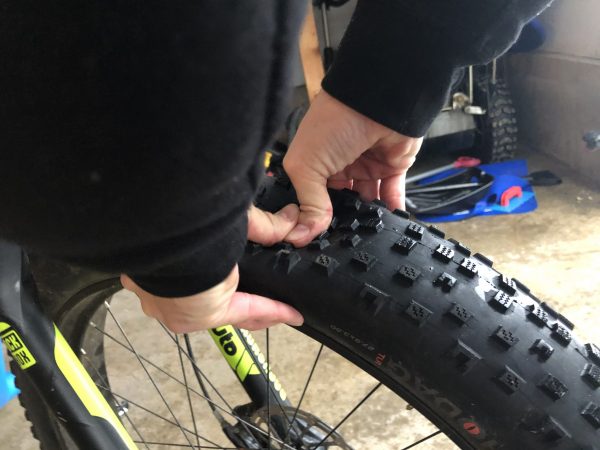
No one enjoys enforcing rules, but sometimes people are oblivious to the damage they are doing. One of the biggest examples of that is creating a rut and not realizing it.
If another rider is not using the trail the right way, try to let them know in the most courteous way possible. Remember that beginners might not know the proper PSI the fat bike tires should have for different types of terrain.
Don’t assume that they are doing things on purpose. If they are purposely messing up the trail, it won’t take long before they are identified and pushed out of using that trail in the future.
A Final Look at Fatbike Trail Grooming
It is not fun nor exciting, but fat bike trail grooming is necessary for everyone to enjoy themselves in adverse weather conditions. The snowy trails are not always great for riding fat bikes on, but a little bit of grooming and care goes a long way.
Whether someone else is taking care of the trails, or a person decides to tackle it on their own, do not gloss over this important step in the process.
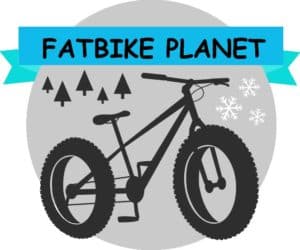
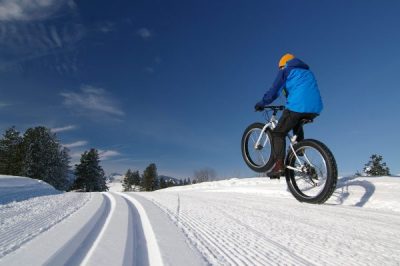
One thought on “How To Groom Fat Bike Trails – Best Snow Trails DIY!”